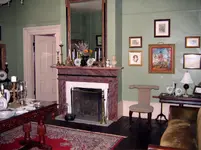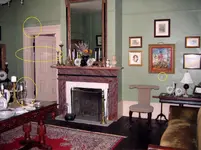Dear CarolinaDigs;
I took the liberty of downloading the first photo which you've posted and reviewed the anamolies for you. First, the orb in the photo is nothing more mysterious than a reflection of the camera's aperture, which is the circular shaped device, usually housed at the innermost part of the lens and it's function is to open and close to in order to regulate the amount light entering the camera and thus striking the sensor's surface. I also call the aperture the iris, which is a depreciated word but still used by some of the older photography crowd.
Now, the foremost and aftmost portions of the camera's lens defines it's focal length and the interaction between the focal length and the aperture's opening is called the f/value. To explain what an f/value is in the simpliest terms, it's the amount of focal length divided by the aperture's opening. For example, your photo was taken with a Canon Powershot A95 point & shoot camera and the f/value at the time of the exposure was f/2.8. This is known as the f/stop and what it means is that the focal length was 2.8 times longer than the aperture's opening at the time the photo was captured.
Because the f/stop was f/2.8 this means that the exposure time would have needed to be raised significantly, which it it in fact was. The exposure time was 1/60th of a second which is a very long time to attempt to hold a camera steady. This is plainly evidenced by the glass candle chimney on the left side of the photo and also the door, again on the left side. The anamolies are known as *ghosting* and they have nothing to do with the supernatural, rather they are caused by not being able to hold the camera steady enough while the image is being captured. A tripod is very helpful in situations such as this.
If you look carefully at the orb in the photo, you may see a series of concentric rings inside of the orb, very similiar to a target. The reason why the orb manifested itself in the photo is because a significant portion of the light reflecting from all of the myriad of reflective glass in the room reflected back to the camera's lens and after entering the lens reflected itself back forward, then backwards, then forward, over and over. This is why the concentric rings may be seen in the photo.
Anamolies such as this are often seen in photos which were taken by inexpensive point & shoot type of cameras. They are nothing more than light beams which are entering the lens element at angles other than straight on, or nearly straight on. Because the light beams enter the lens at such extreme angles they tend to reflect off of the inner surface of the lens barrel then off of the sensor's surface then back to the rear side of the frontmost lens element, whereby the reflection cycle repeats itself.
The easiest way to preclude this phenomenon from occurring would be to use a lens hood in order to protect the lens element from intercepting light rays which would otherwise enter the lens group at an extreme angle, however most point & shoot cameras do not have an option to attach a lens hoods to the lens, therefore the next best thing would be to purchase an entry level dSLR camera.
Entry level dSLR cameras have really dropped in price in recent years and they are comparible to the high end point & shoots. Also, and more important, is the fact that even the least expensive dSLR camera lenses incorporate vastly superior lens coatings than what are used in point & shoot cameras, and the anti-reflective coatings almost completely eliminates orbs, which most photographers know as spherical aberrations. For example, when I was still using a point a shoot camera, I would encounter orbs in about one out of every 15 to 30 shots, whereas I now use a Sony dSLR camera with a top end Zeiss lens with lens hood and I have encountered perhaps 4 orbs out of more than 5,000 photos taken whilst using this particular lens.
If a dSLR camera is not in your immediate future, then another method to try would be to use a white business card and tape it directly underneath the cameras' flash, with the card bent upwards at a roughly 45 degree angle. This will help direct the cameras' flash to the ceiling and if the ceiling is white, it will be used as a highly reflective surface which will scatter the strobes' flash downwards and outwards, thereby brightening the scene while at the same time softening the coldness of the image.
Also, by forcing the cameras' flash to fire it will automatically decrease the exposure time which will shorten the shutter speed, thereby reducing or eliminating the ghosting effects.
Granted, this will not entrely eliminate spherical aberrations when using a point & shoot camera but it will lessen the amount of photographs with spherical aberrations and also tends to make the photos with aberrations less visible.
Good luck and keep taking those pictures, everyone!
Your friend;
LAMAR










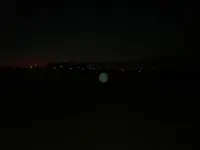
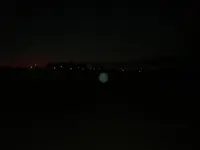


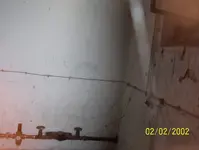

 This room has a lot of activity most often feeling like someone is often in the room with you
This room has a lot of activity most often feeling like someone is often in the room with you 